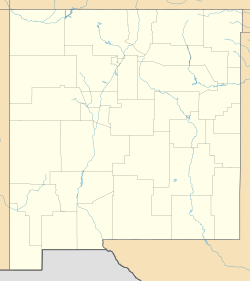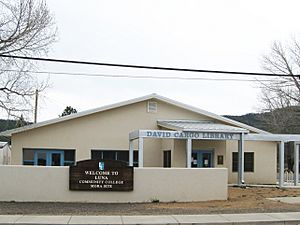Mora, New Mexico facts for kids
Quick facts for kids
Mora, New Mexico
|
|
|---|---|
| Country | United States |
| State | New Mexico |
| County | Mora County |
| Elevation | 7,172 ft (2,186 m) |
| Time zone | UTC-7 (MST) |
| • Summer (DST) | UTC-6 (MDT) |
| ZIP Code |
87732
|
| Area code | 575 |
| FIPS code | 35-50090 |
| GNIS feature ID | 0915867 |
Mora or Santa Gertrudis de lo de Mora is a census-designated place in, and the county seat of, Mora County, New Mexico. It is located about halfway between Las Vegas and Taos on Highway 518, at an altitude of 7,180 feet. The Republic of Texas performed a semi-official raid on Mora in 1843. Two short battles of Mexican–American War were fought in Mora in 1847, where U.S. troops eventually defeated the Hispano and Puebloan militia, effectively ending the Taos Revolt in the Mora Valley. The latter battle destroyed most of the community, necessitating its re-establishment.
Mora includes three plazas and four settlements: Mora proper, Cleveland (originally named San Antonio), Chacon, and Holman (without a plaza, and originally named Agua Negra) lying between Chacon and Cleveland. In the mid-19th century, there were two settlements, Upper and Lower Mora.
History
Hispanic settlers had occupied lands within the Mora Valley without legal title ever since Governor de Anza had made peace with the Comanches in the late 18th century opening up the east side of the Sangre de Cristo Mountains for settlement. However, Mora was formally founded as a farming community in 1835 The settlers came primarily from Las Trampas, but also from Picuris and Embudo. The 76 families each received a strip of land by grant of Governor Albino Perez. Despite fanciful stories about fur trappers, scattered bones and subsistence on mulberries (mora means mulberry in Spanish), the fact is that the valley, the river and the town took their name from the family name "Mora" of several of the settler families.
In 1843, there was a raid on the town by Texas freebooters under Colonel Charles A. Warfield claiming that the people in Mora had purchased stolen beef from the Comanches. The Texans killed five men and took eighteen women and children captive as well as 75 horses. The people of the Mora Valley convened a posse, overtook the Texans, and sent them back to Texas on foot.
In 1847, after the Battle of Mora, Federal troops killed stragglers, looted and burned the town, the nearby ranches, and all the crops. The town was essentially destroyed and was rebuilt by the insurgents who had fled at the news of artillery coming up the valley. After 1851 when Fort Union was established on the Santa Fe Trail, these same farmers sold their crops to the fort.
Ceran St. Vrain settled in Mora in 1853 built a grist mill and became a major supplier of flour, grain and fodder to Fort Union. At the peak in the 19th century there were five grist mills operating in Mora. The ruins of St. Vrain’s mill still sit one block north of Mora’s main street.
On 22 February 1916, the common lands of the Mora landgrant are sold to "The State Investment Company" at the courthouse door in Mora. Without access to the grazing and timbering lands, many residents sought work outside Mora.
Notable people
- Floyd Esquibel, member of the Wyoming Senate and former member of the Wyoming House of Representatives, was born in Mora on August 27, 1938.
- Ceran St. Vrain (1802 - 1870), a trapper and successful trader, who later became a military volunteer unit leader against the Taos Revolt. He moved to Mora in 1855 to open a grain mill, and later started one of Northern New Mexico's first English-language newspapers, the Santa Fe Gazette. He died in Mora in 1870, and had a funeral attended by over 2000, including the Fort Union garrison.
- Abraham Ledoux (1784-1842) and Antoine Ledoux (1779 - ?), two French brothers born in Québec, who became trappers and settled in Mora, New Mexico and Taos, New Mexico. The incorporated village of 'Ledoux' in Mora County and a street in Taos are named after them.
See also
 In Spanish: Mora (Nuevo México) para niños
In Spanish: Mora (Nuevo México) para niños




